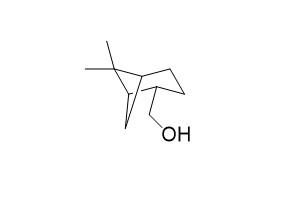(1S,2S,5S)-(-)-Myrtanol
(1S,2S,5S)-(-)-Myrtanol shows anti-bacteria against nine harmful intestinal bacteria.
Inquire / Order:
manager@chemfaces.com
Technical Inquiries:
service@chemfaces.com
Tel:
+86-27-84237783
Fax:
+86-27-84254680
Address:
1 Building, No. 83, CheCheng Rd., Wuhan Economic and Technological Development Zone, Wuhan, Hubei 430056, PRC
Providing storage is as stated on the product vial and the vial is kept tightly sealed, the product can be stored for up to
24 months(2-8C).
Wherever possible, you should prepare and use solutions on the same day. However, if you need to make up stock solutions in advance, we recommend that you store the solution as aliquots in tightly sealed vials at -20C. Generally, these will be useable for up to two weeks. Before use, and prior to opening the vial we recommend that you allow your product to equilibrate to room temperature for at least 1 hour.
Need more advice on solubility, usage and handling? Please email to: service@chemfaces.com
The packaging of the product may have turned upside down during transportation, resulting in the natural compounds adhering to the neck or cap of the vial. take the vial out of its packaging and gently shake to let the compounds fall to the bottom of the vial. for liquid products, centrifuge at 200-500 RPM to gather the liquid at the bottom of the vial. try to avoid loss or contamination during handling.
Mol Med Rep.2014, 9(5):1653-9
World J Mens Health.2019, 10.5534
J Nat Prod.2022, 85(5):1351-1362.
Cell Signal.2022, 99:110433.
Cell Physiol Biochem.2017, 43(4):1425-1435
Pharmacognosy Magazine2024, 20(2):632-645.
Journal of Food Quality2022, P:13, 6256310.
Acta horticulturae2017, 1158:257-268
Plants (Basel).2024, 13(23):3314.
Cell Mol Biol (Noisy-le-grand).2023, 69(15):167-173.
Related and Featured Products
World Journal of Microbiology & Biotechnology, 2012, 28(2):1575-1583.
Growth-inhibiting effects of Paeonia lactiflora root steam distillate constituents and structurally related compounds on human intestinal bacteria.[Reference:
WebLink]
METHODS AND RESULTS:
The growth-inhibiting activities of Paeonia lactiflora (Paeoniaceae) root steam distillate constituents and structurally related compounds against nine harmful intestinal bacteria and eight lactic acid-producing bacteria were compared with those of two antibiotics, amoxicillin and tetracycline. Thymol, α-terpinolene, (−)-perilla alcohol and (1R)-(−)-myrtenol exhibited high to extremely high levels of growth inhibition of all the harmful bacteria, whereas thymol and α-terpinolene (except for Lactobacillus casei ATCC 393) inhibited the growth of all the beneficial bacteria (MIC, both 0.08–0.62 mg mL−1). Tetracycline and amoxicillin exhibited extremely high level of growth inhibition of all the test bacteria (MIC, <0.00002–0.001 mg mL−1). 1,8-Cineole, geraniol, (−)-borneol, (1S,2S,5S)-(-)-Myrtanol, nerol, (S)-(−)-β-citronellol and (±)-lavandulol also exhibited inhibitory activity but with differing specificity and levels of activity.
CONCLUSIONS:
Structure–activity relationship indicates that structural characteristics, such as geometric isomerism, degrees of saturation, types of functional groups and types of carbon skeleton, appear to play a role in determining the growth-inhibiting activity of monoterpenoids. Global efforts to reduce the level of antibiotics justify further studies on naturally occurring P. lactiflora root-derived materials as potential preventive agents against various diseases caused by harmful intestinal bacteria such as clostridia.
Formononetin-8-C-beta-D-apiofuranosyl-(1->6)-O-beta-D-glucopyranoside
Catalog No: CFN95157
CAS No: 1147858-78-3
Price: $318/10mg
[(1(10)E,2R,4R)]-2-Methoxy-8,12-epoxygemacra-1(10),7,11-trien-6-one
Catalog No: CFN95198
CAS No: 75412-95-2
Price: $318/10mg
Aegineoside
Catalog No: CFN95270
CAS No: 752209-48-6
Price: $413/5mg
Margaritene
Catalog No: CFN95303
CAS No: 64271-10-9
Price: $318/10mg
New compound 11
Catalog No: CFN95351
CAS No: N/A
Price: $318/10mg
3-O-Methylellagic acid 3'-O-alpha-rhamnopyranoside
Catalog No: CFN95375
CAS No: 352280-34-3
Price: $413/5mg
Naringenin 7-O-gentiobioside
Catalog No: CFN95435
CAS No: 104154-33-8
Price: $368/5mg
3beta-(alpha-L-Arabinopyranosyloxy)urs-12,18-dien-28-oic acid beta-D-glucopyranosyl ester
Catalog No: CFN95459
CAS No: 435269-07-1
Price: $318/20mg
12beta-Acetoxy-3beta-hydroxy-7,11,15,23-tetraoxo-lanost-8,20-diene-26-oic acid
Catalog No: CFN95468
CAS No: 1085338-75-5
Price: $318/5mg
Methyl nomilinate
Catalog No: CFN95576
CAS No: 77887-51-5
Price: $318/5mg



